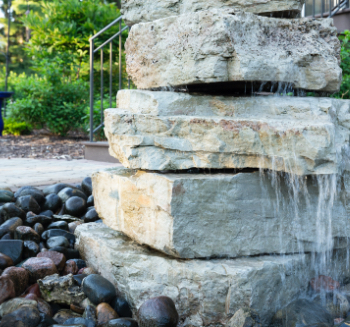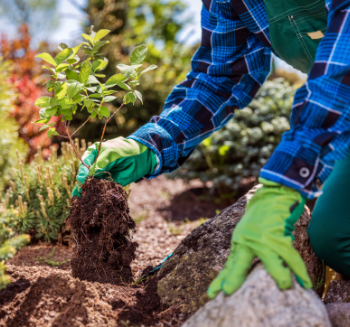Outdoor Style Guide: 5 Landscape & Hardscape Ideas for Walkways
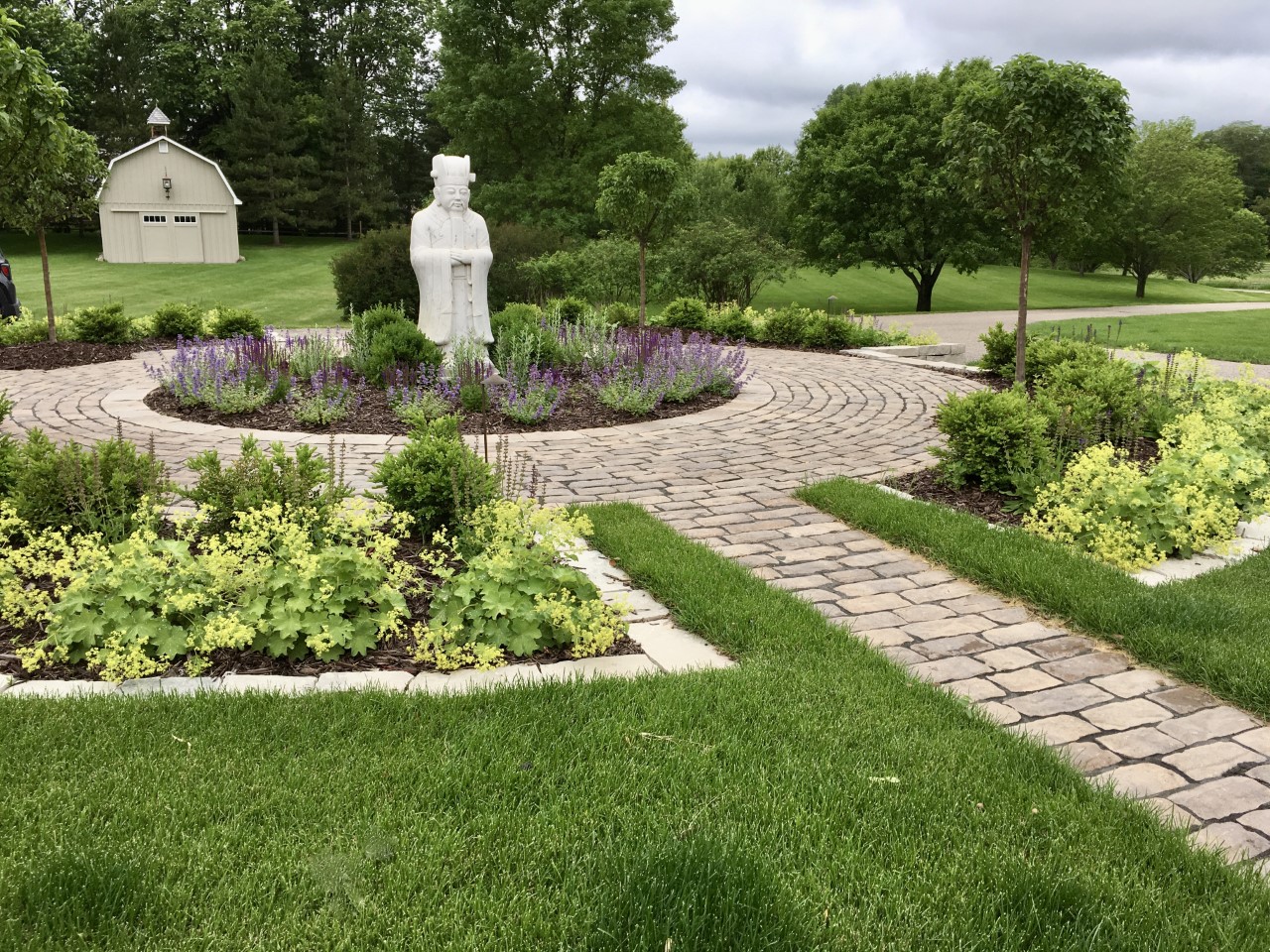
A well-designed walkway is one of the most crucial elements of any landscape, as it brings the home and yard together in a way that nothing else can. Like your home, a walkway should blur the lines between practicality and elegance, bringing people where they need to go while highlighting the rest of your yard in the process.
Installing a tried-and-true walkway is easy. Creating one that is both uniquely stylish and effortlessly functional takes quite a bit more work. To that end, here are 5 landscaping tips to help turn your boring old stroll into a breathtaking backyard excursion.
1. Hardscape Walkways: The Width Says More Than You Think
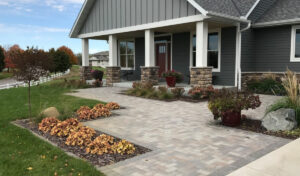
How wide should an outdoor walkway be? The width of a walkway can vary greatly depending on its location, purpose, and frequency of use.
- In general, wider walkways (36–60 inches) are more inviting and thus are a great choice for your front entryway in particular.
- Walkways on the side of the house are typically narrower (18–24 inches) as they provide a more serviceable means of connecting the front yard to the back.
- Backyard walkways, on the other hand, should be proportional to the size of your space and the reason for the path. If you’re leading to a pool or an outdoor kitchen, opt for a wider walkway. If it’s a meandering garden path, it’ll benefit from being smaller and more intimate.
Of course, your walkway doesn’t have to be one set width. Mix it up a bit and use wider sections of your path to highlight interesting features of your yard or provide extra space to sit down on a bench or chair.
2. Enhance Garden Path Paving with a Variety of Plants
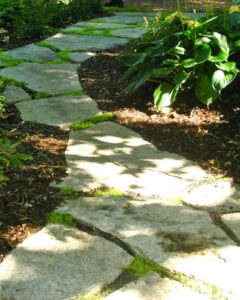
Your walkway shouldn’t just look like an extension of your city’s sidewalks. Your home is full of life, and your paths should be no different. Soften the space between your pavers or stepping stones with a touch of green. Not only is garden path edging visually appealing, but it’s a great way to tie your house and yard/garden together.
When choosing your plants, make sure you pick something that won’t grow too tall and can be walked on, such as Irish moss, turfgrass, or baby’s tears. We recommend consulting your local garden center to determine which option is most appropriate for your climate.
Sight isn’t the only sense to appeal to when constructing your walkway. One particular trend that’s growing in popularity is the incorporation of creeping thyme or mint to add a pleasant aroma for your walkway’s travelers to enjoy.
3. Use Paver Walkway Patterns to Add Curves to Longer Paths
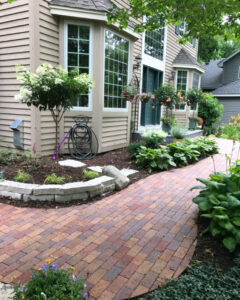
While short paths benefit the most from going straight from point A to point B, a longer path allows more flexibility in design. A curved path is much more interesting and begs the eyes (and legs) to follow.
- Adding gentle curves is a great way to effortlessly navigate around trees, corners, and other obstacles without presenting the hard stop of a 90° angle.
- Just be careful not to stray too far from the quickest route. An unnecessarily windy path will only annoy your frequent visitors and run the risk of having your grass or other plants trampled by those who can’t be bothered to follow your labyrinthine designs.
Tip: Walkway Paver Ideas for Cold Climates
If you're looking for walkway paver ideas for your home in Minnesota, Wisconsin or other colder climates, you'll want to consider the paver material you use.
Brick tends to be the best walkway material for colder climates due to it's integrity to withstand freeze-thaw conditions, while also providing a slip resistant surface that holds up better in icy conditions.
Handling Uneven Terrain and Muddy Areas
A boardwalk can be an excellent solution when dealing with uneven terrain or muddy areas. Boardwalks provide a stable and attractive way to navigate through these challenging spots while addressing drainage issues effectively.
- Uneven Terrain: Boardwalks are particularly useful for uneven terrain as they can be elevated and leveled, providing a smooth, even walking surface regardless of the ground below.
- Drainage: Proper drainage is crucial in areas prone to mud and standing water. Elevating the walkway with a boardwalk allows water to flow underneath, preventing puddles and maintaining a dry, safe path.
4. Use Materials That Complement the Style of Your Home
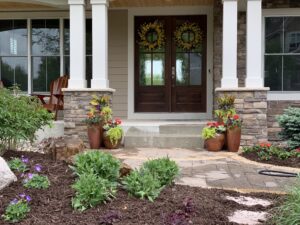
Think of your walkways as the outreached arms of your home. The materials you choose should look like they were cut from the same cloth.
- If your home has natural stone or brickwork, your path should too. If your house is lighter in color, opt for lighter materials. You get the idea.
- This doesn’t mean you should limit yourself to just one type of material, either. If your home has a primary and secondary color, for example, your walkways can benefit from that two-tone look as well.
Material Ideas for Hardscape Walkways:
- Bluestone: Offers a sleek, durable surface with a classic look.
- Flagstone: Provides a natural, rustic appearance that complements many home styles.
- Pavers: Versatile and available in various patterns like herringbone and basket weave.
Environmentally Friendly Walkway Solutions
Incorporating environmentally friendly materials into your walkway design not only benefits the planet but also enhances the functionality and longevity of your outdoor space. One excellent solution is using permeable pavers.
Permeable Pavers for Sustainable Landscaping
Permeable pavers are designed to allow rainwater to flow through the joints between the pavers, reducing runoff and helping water return to the soil. This environmentally friendly option can help manage stormwater, prevent erosion, and maintain the natural water cycle.
Benefits of Permeable Pavers:
- Enhanced Drainage: Permeable pavers facilitate the infiltration of rainwater, reducing the risk of flooding and pooling on your walkway.
- Erosion Control: By allowing water to pass through, these pavers help prevent soil erosion, maintaining the integrity of your landscape.
- Sustainability: Permeable pavers are often made from recycled materials, contributing to a lower environmental impact.
- Aesthetic Appeal: Available in various styles and colors, permeable pavers can be just as attractive as traditional options, offering both beauty and sustainability.
Implementing Permeable Pavers
When considering permeable pavers for your walkway, it's essential to ensure proper installation. This includes preparing a suitable base layer of crushed stone to support drainage and prevent compaction.
5. Every Walkway is a Journey, But It Needs a Destination
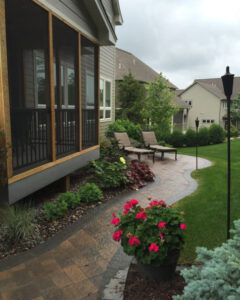
A pathway—such as one that meanders freely through a yard or garden—can simply take you along a scenic route for no other purpose than to explore a particular space. A walkway, however, should have a destination. Before you install your walkway, you need to determine what its purpose will be and where it will take you.
- It could be as practical as leading you from the driveway to the backdoor, or as recreational as taking you to a fire feature, gazebo, water feature, outdoor kitchen, or other outdoor living spaces.
Design the Yard of Your Dreams with Help from Dundee
Are you ready for a new walkway but not sure where to start? Perhaps you want an eye-catching feature for that walkway to lead. Whatever your needs, it’s time to meet the landscape design experts at Dundee. We’ve been brightening Minnesota landscapes for over 70 years and are ready to do the same for yours.
Contact us today to schedule a one-on-one design consultation.


